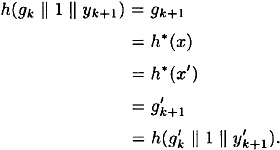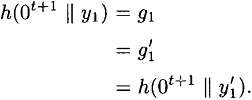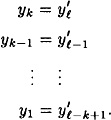Cryptography: Theory and Practice:Hash Functions
 | Cryptography: Theory and Practice by Douglas Stinson CRC Press, CRC Press LLC ISBN: 0849385210 Pub Date: 03/17/95 |
| Previous | Table of Contents | Next |
THEOREM 7.3
Suppose h :  is a strongly collision-free hash function, where m ≥ t + 2. Then the function h* :
is a strongly collision-free hash function, where m ≥ t + 2. Then the function h* :  , as constructed in Figure 7.4, is a strongly collision-free hash function.
, as constructed in Figure 7.4, is a strongly collision-free hash function.
PROOF Suppose that we can find x ≠ x′ such that h*(x) = h*(x′). Given such a pair, we will show how we can find a collision for h in polynomial time. Since h is assumed to be strongly collision-free, we will obtain a contradiction, and thus h* will be proved to be strongly collision-free.
Denote

and

where x and x′ are padded with d and d′ 0’s, respectively, in step 2. Denote the values computed in steps 4 and 5 by g1,...,gk+1 and  , respectively.
, respectively.
We identify two cases, depending on whether or not |x| ≡ |x′| (mod m-t-1).
- case 1:
 (mod m - t - 1).
(mod m - t - 1). Here d ≠ d′ and
 . We have
. We have
which is a collision for h since
 .
.- case 2: |x| ≡ |x′| (mod m - t - 1).
It is convenient to split this into two subcases:
- case 2a: |x| = |x′|.
Here we have
 and
and  . We begin as in case 1:
. We begin as in case 1:
If
 , then we find a collision for h, so assume
, then we find a collision for h, so assume  . Then we have
. Then we have
Either we find a collision for h, or
 and
and  . Assuming we do not find a collision, we continue working backwards, until finally we obtain
. Assuming we do not find a collision, we continue working backwards, until finally we obtain
If
 , then we find a collision for h, so we assume
, then we find a collision for h, so we assume  . But then
. But then  for 1 ≤ i ≤ k + 1, so y(x) = y(x′). But this implies x = x′ since the mapping
for 1 ≤ i ≤ k + 1, so y(x) = y(x′). But this implies x = x′ since the mapping  is an injection. Since we assumed x ≠ x′, we have a contradiction.
is an injection. Since we assumed x ≠ x′, we have a contradiction. 
Figure 7.5 Extending a hash function h to h* (m = t + 1)- case 2b: |x| ≠ |x′|.
Without loss of generality, assume |x′| > |x|, so
 . This case proceeds in a similar fashion as case 2a. Assuming we find no collisions for h, we eventually reach the situation where
. This case proceeds in a similar fashion as case 2a. Assuming we find no collisions for h, we eventually reach the situation where 
But the (t + 1)st bit of 0t+1 || y1 is a 0 and the (t + 1)st bit of
 is a 1. So we find a collision for h.
is a 1. So we find a collision for h. - case 2: |x| ≡ |x′| (mod m - t - 1).
Since we have considered all possible cases, we have the desired conclusion.
The construction of Figure 7.4 can be used only when m ≥ t + 2. Let’s now look at the situation where m = t + 1. We need to use a different construction for h*. As before, suppose |x| = n > m. We first encode x in a special way. This will be done using the function f defined as follows:

The algorithm to construct h* (x) is presented in Figure 7.5.
The encoding  , defined in step 1, satisfies two important properties:
, defined in step 1, satisfies two important properties:
- 1. If x ≠ x′, then y(x) ≠ y(x′) (i.e.,
 is an injection).
is an injection).- 2. There do not exist two strings x ≠ x′ and a string z such that y(x) = z || y(x′). (In other words, no encoding is a postfix of another encoding. This is easily seen because each string y(x) begins with 11, and there do not exist two consecutive 1’s in the remainder of the string.)
THEOREM 7.4
Suppose h :  is a strongly collision-free hash function. Then the function h* :
is a strongly collision-free hash function. Then the function h* :  , as constructed in Figure 7.5, is a strongly collision-free hash function.
, as constructed in Figure 7.5, is a strongly collision-free hash function.
PROOF Suppose that we can find x ≠ x′ such that h* (x) = h* (x′). Denote

and

We consider two cases.
- case 1:
 .
.As in Theorem 7.3, either we find a collision for h, or we obtain y = y′. But this implies x = x′, a contradiction.
- case 2:
 .
.Without loss of generality, assume
 . This case proceeds in a similar fashion. Assuming we find no collisions for h, we have the following sequence of equalities:
. This case proceeds in a similar fashion. Assuming we find no collisions for h, we have the following sequence of equalities: 
But this contradicts the “postfix-free” property stated above.
- case 2:
We conclude that h* is collision-free.
We summarize the two constructions of in this section, and the number of applications of h needed to compute h*, in the following theorem.
THEOREM 7.5
Suppose h :  is a strongly collision-free hash function, where m ≥ t + 1. Then there exists a strongly collision-free hash function
is a strongly collision-free hash function, where m ≥ t + 1. Then there exists a strongly collision-free hash function

The number of times h is computed in the evaluation of h* is at most

where |x| = n.
7.6 Hash Functions from Cryptosystems
So far, the methods we have described lead to hash functions that are probably too slow to be useful in practice. Another approach is to use an existing private-key cryptosystem to construct a hash function. Let us suppose that  is a computationally secure cryptosystem. For convenience, let us assume also that
is a computationally secure cryptosystem. For convenience, let us assume also that  . Here we should have n ≥ 128, say, in order to prevent birthday attacks. This precludes using DES (as does the fact that the key length of DES is different from the plaintext length).
. Here we should have n ≥ 128, say, in order to prevent birthday attacks. This precludes using DES (as does the fact that the key length of DES is different from the plaintext length).
Suppose we are given a bitstring

where  . (If the number of bits in x is not a multiple of n, then it will be necessary to pad x in some way, such as was done in Section 7.5. For simplicity, we will ignore this now.)
. (If the number of bits in x is not a multiple of n, then it will be necessary to pad x in some way, such as was done in Section 7.5. For simplicity, we will ignore this now.)
The basic idea is to begin with a fixed “initial value” g0 = IV, and then construct g1,...,gk in order by a rule of the form

where f is a function that incorporates the encryption function of our cryptosystem. Finally, define the message digest h(x) = gk.
| Previous | Table of Contents | Next |
Copyright © CRC Press LLC
EAN: 2147483647
Pages: 133
- Chapter III Two Models of Online Patronage: Why Do Consumers Shop on the Internet?
- Chapter X Converting Browsers to Buyers: Key Considerations in Designing Business-to-Consumer Web Sites
- Chapter XI User Satisfaction with Web Portals: An Empirical Study
- Chapter XV Customer Trust in Online Commerce
- Chapter XVI Turning Web Surfers into Loyal Customers: Cognitive Lock-In Through Interface Design and Web Site Usability